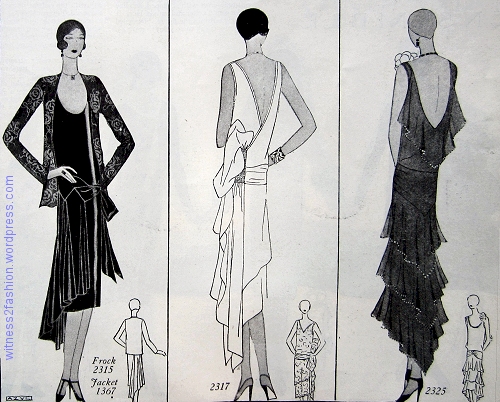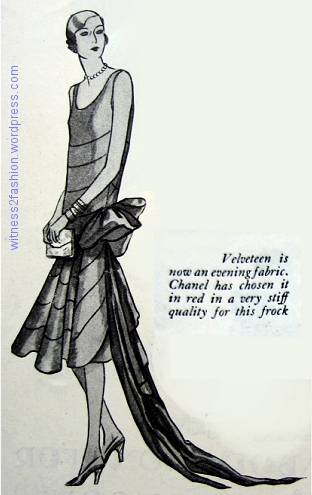This is a variation on my “Hems Going Down” posts. (Part 1: 1926) (Part 2: 1928.) While collecting images of 1920’s dresses with high-low hemlines, side drapes, back drapes, and handkerchief hems, I realized that I had quite a lot of pictures of late twenties’ dresses with tiers of flounces, often sharing a page with dresses that feature gigantic bows which flow into side drapes, etc.
Paris led the way, with couture frocks of increasing complexity. This simple, flounced, formal gown is by Chanel:
“This frock, stiffened at the edges, embroidered with chenille, is black net. From Chanel.”
So is this much more complicated red gown, trimmed with a huge bow:
“Velveteen is now an evening fabric. Chanel has chosen it in red in a very stiff quality for this frock.” The complexity of that cut would be daunting for a stitcher, in any fabric!
“This is the new tulle frock of the winter — it is all in tulle, from flowers to hemline. Lelong.” Note Lelong’s indecision about the waistline, with the dress’ belt lower than the waist of the slip.
“White chiffon and the glitter of white strass and crystal beads are used by Vionnet for this frock.” ‘Strass’ refers to a type of rhinestone. The skirt looks heavy with beading, and it seems to have a draped (cowl) neckline.
“Here Louiseboulanger has revived old-fashioned brocaded satin in brilliant yellow.” [Louise Boulanger’s design house used her name as one word, frequently all in lowercase letters.] Note the enormous amount of fabric used in the side drape — perhaps as much as used for the dress itself!
These dresses by Chanel and Lelong illustrate the accompanying text from The Delineator:
“The full skirt . . . drops at the back in a graceful point almost touching the floor, with a molded bodice cut higher than the slip, giving the effect of a transparent yoke of lace or chiffon . . . . The skirts, almost without exception, have an uneven hemline, and while the favorite movement is toward the back, there are many which have a diagonal line with a deep point on one side. [Like the Vionnet.]“
If there was any doubt about how quickly Butterick’s Paris office could translate designer fashions into patterns for its customers, here are six Butterick patterns which appeared in that same November 1928 issue of Butterick’s Delineator magazine:

“For Dancing, Dining and the Opera,” Butterick patterns 2312, 2314, 2307. Delineator, Nov. 1928. The center dress, if made in softer fabric and without the rose trim, would come very close to the black, chenille-embroidered Chanel.

Dresses “for Dancing, Dining and the Opera,” Delineator, Nov. 1928. Butterick patterns 2315, 2317, 2325. Jacket 1367. The jacket was called a “bridge jacket.”
The bow construction on Butterick 2317 deserves a closer look:
Tiers and flounces were also featured in these 1928 patterns:

Butterick patterns 2325, 2314. Delineator, Dec. 1928. The afternoon dress on the left has a high-low hem.

Butterick patterns 2297. 2301, and 2315. Nov. 1928; Delineator. [The dress on the right, made sleeveless, is the black evening dress shown above with a bridge jacket.]
The one on the left above has flounces and a bow. The high/low-hemmed dress at right is for a young woman.

“This lace frock is the most formal of daytime fashions.” Butterick 2430. Butterick 2446, right, has a cowl neckline attributed to Vionnet. It’s rather austere, except for its enormous bow. Feb. 1929, Delineator.

Flounces and great big bows: Butterick patterns 2448 and 2468, Delineator, Feb. 1929. The “bow” on the left seems to be flounces stiffened with horsehair.
Nothing succeeds like excess.
Although the “pillow” bow on the right is outrageous, the curved seams in the chiffon dress (far left) and the lace dress (center right) are real tests of sewing skill. The lace dress has both the uneven hem and sheer top [“the effect of a transparent yoke of lace or chiffon . . . . The skirts, almost without exception, have an uneven hemline.”] described in The Delineator.











I love these dresses, so beautiful and such detail.
I wonder how the velveteen would hang in the Chanel design. The drawing makes it look quite fluid, but the text describes it as a ‘stiff quality’.
Maybe someone can find a photo? I find it hard to believe this was a successful dress — all those seams in velveteen? Perhaps it was a softer, more loosely woven velveteen than the kinds I’ve worked with.
I found a similar red dress on Pinterest, but I can’t see the seams. I can’t join Pinterest because I don’t want to join Facebook or Twitter, so here’s the link for anyone who can use it https://www.pinterest.com/evelynperusco/fashion-1920s/
Well, I still don’t like those uneven hems and the ones that drag on the floor are just silly. Anyone who thinks Chanel succeeded because of the simplicity of her designs should look at these.
Maybe trains are part of planned obsolescence. I don’t remember how many vintage evening dresses I saw that were perfect except for a missing piece at the hem in back!
The curved skirt seams of the chiffon dress in the last photo – SWOON!
Lovely to look at — Only a super-stitcher like you would want to tackle that dress! One of my worst experiences was asymmetrical bias-cut chiffon panels for a many-gored skirt; they stretched so badly after hanging for two days that we couldn’t tell which pattern piece they started as (left side front? right side side back?) — and, because it was very pale chiffon, we hadn’t marked the usual stitch lines on the inside of each piece. We couldn’t tell which side was “out” either. All the stretched fabric pieces had become much thinner and much longer than any of the paper pattern pieces. Eventually the cutter/draper figured it out and put a tiny, matte scotch tape label
Yes, chiffon is definitely not a fabric that can be rushed! And if someone else cuts it out and hands it to you, it’s almost always more confusing than if you had just cut it yourself.
Another lovely post. Thank you for the photos and all of your comments and explanations!